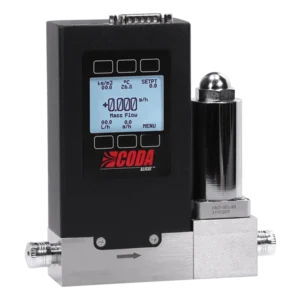Nanocomposite Materials for Environmental Monitoring

Summary
- Modern industrialization has created unique challenges for air and water quality analysis.
- New generations of nanocomposite materials are transforming environmental monitoring with faster, smarter, and more reliable sensors.
- MXenes, a new class of 2D materials, stand out for their flexibility, conductivity, and ability to detect both toxic gases and waterborne pollutants.
- By pairing these materials with advanced flow-control tools, researchers are able to test and validate their sensitivity to toxic gases and pollutants, making them more adaptable than ever.
- The long-term vision: portable, real-time sensing networks embedded in cities, industries, and natural ecosystems to keep people and the environment safe.
Environmental monitoring

As a result, environmental monitoring has become increasingly important. By tracking air quality and pollutants, agencies and governments can make informed decisions to protect both urban and natural systems. Monitoring gases like nitrogen dioxide (NO2), carbon monoxide (CO), methane (CH4), and ammonia (NH3) helps assess air quality and its effects on public health. In water systems, checking for contaminants such as heavy metals, pesticides, antibiotics, and phenolic compounds, helps prevent long-term risks to biodiversity and water security.
To address these challenges, sensing devices have been deployed across air, water, and soil systems. These sensors can detect low levels of pollutants and, in some cases, provide continuous real-time data to support policy, guide industry, and promote sustainable development. However, current technologies still face major limitations. Many are too expensive, too specialized, or too fragile for large-scale use. This has created a strong need for new sensing platforms that are more sensitive, selective, and adaptable.
In this context, nanomaterials—particularly MXenes—are transforming what environmental monitoring can achieve.
Chemiresistive gas sensing
Despite their promise, chemiresistive sensors face longevity challenges. Their performance often depends on environmental factors such as humidity and temperature, which can cause signal drift or reduce accuracy. Many also suffer from limited selectivity, responding to multiple gases in similar ways, and can degrade over time due to surface contamination or material instability. These issues make their applicability limited by operational lifespan, maintenance needs, or calibration costs, particularly in continuous or large-scale monitoring systems.
To overcome these limitations, researchers are exploring nanomaterials that enhance key sensor properties by increasing surface area, improving conductivity, and introducing catalytic activity.
Among these materials, MXenes have become a particularly promising choice. They are thin, two-dimensional layers of metal carbides or nitrides that conduct electricity well and have surfaces that easily attract gas molecules. When these molecules attach to the surface, the MXene’s resistance changes—making it useful as a chemiresistive sensor.
MXenes can also be combined with other materials to make sensors more stable and selective. For example, coatings like titanium dioxide can protect MXenes from oxidation, maintain conductivity, and even add photocatalytic self-cleaning properties. These hybrid designs last longer and perform better, making MXene-based sensors more practical for continuous air-quality monitoring.
Calibrating sensors in the lab

Researchers typically expose sensors to known concentrations of target gases at various pressures and flow rates, then analyze how the materials respond. Even minor fluctuations in gas delivery can affect results, making precision and repeatability critical for credible data.
To achieve this level of control, university researchers used an Alicat® Scientific CODA™ Coriolis mass flow controller to deliver precisely regulated gas flows during calibration and testing. The CODA provided stable, repeatable delivery of gases such as carbon dioxide, methane, and nitrogen dioxide at concentrations between 10 and 500 ppm and pressures up to 15 MPa.
Its material compatibility and high-pressure tolerance enabled safe, reliable operation under demanding test conditions. This allowed researchers to confirm that the sensors maintained stable performance in environments comparable to those found in real-world monitoring systems.
The future of environmental monitoring
Full-scale deployment of these sensors still faces several hurdles. Scaling up production remains difficult, sustainability concerns must be addressed, and costs need to come down for sensors to be widely adopted. Even with promising lab results, more practical testing and validation are required before these systems can become reliable, everyday tools.
Despite these challenges, commercial gas sensors are advancing with digital interfaces, greater accuracy, and IoT connectivity. Together with continued research, these innovations are steadily pushing environmental sensing toward the end goal: accurate, sustainable systems that can be more effectively implemented across urban and remote areas to protect both people and ecosystems. Gone are the days of relying on canaries in coal mines—the future of environmental sensing is smaller, smarter, and far more powerful.
Executive Summary
- MXenes and other nanocomposites are enhancing gas sensing capabilities in air and water monitoring capabilities
- Major challenges such as scalability, long-term stability, cost, and sustainability have yet to be conquered
- Continued research into Mxenes and nanomaterials for environmental monitoring will is essential to reach practical, urban depoloyment
- The monitoring industry as a whole is benefitting from sustained research, commercial sensors are being released with digital interfaces, IoT connectivity, and better results